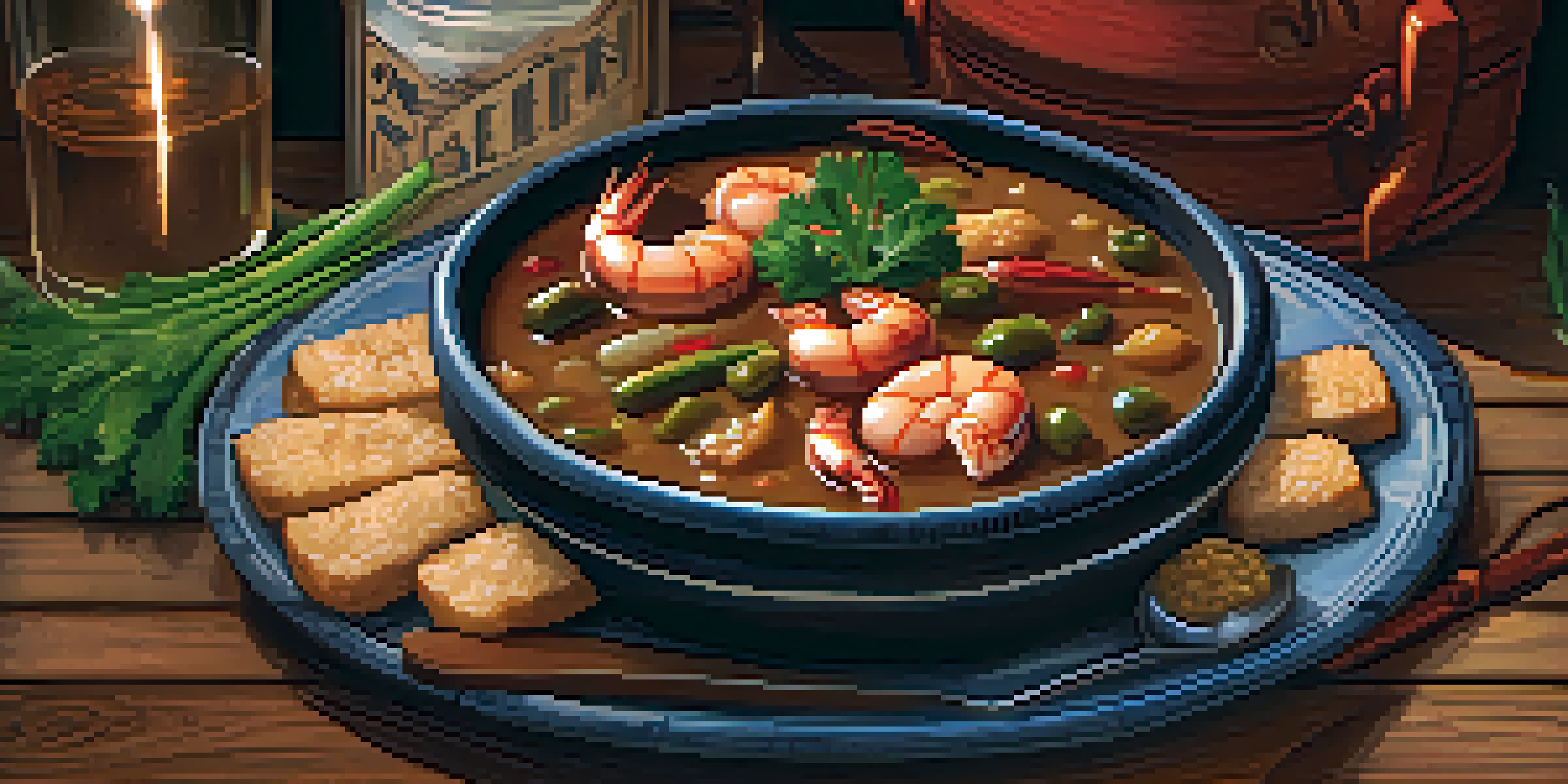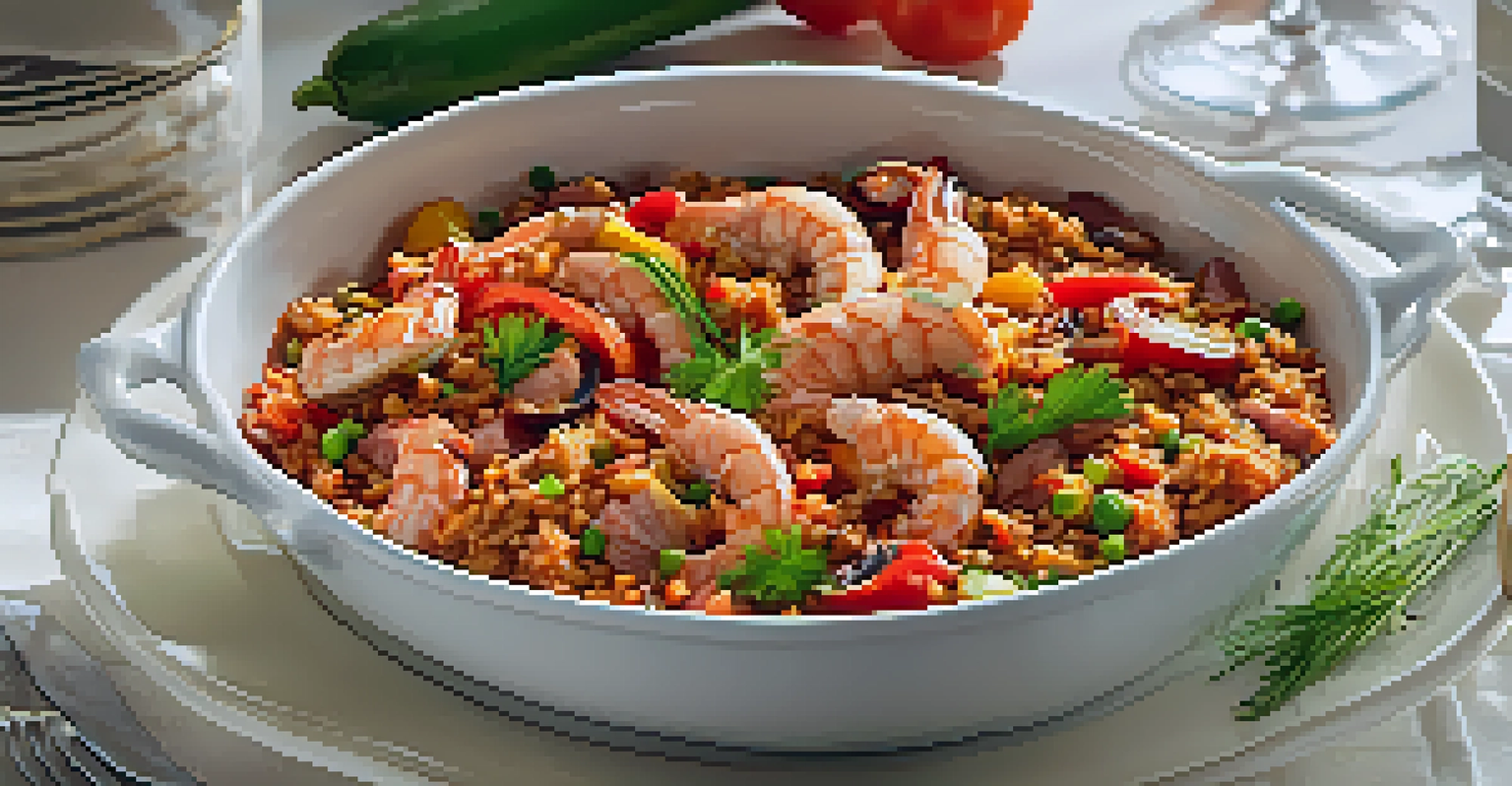Cajun vs. Creole: Understanding Louisiana's Culinary Roots

Cajun Cuisine: A Flavorful Journey from Rural Roots
Cajun cuisine has its origins in the rural communities of Louisiana, particularly among the Acadian people. Known for its robust flavors and hearty dishes, Cajun cooking reflects a resourceful approach to food, often utilizing local ingredients. Staples like rice, seafood, and game are prevalent, showcasing the bounty of the bayou and surrounding areas.
Food is the ingredient that binds us together.
One of the most iconic Cajun dishes is gumbo, a thick stew that varies widely among families and regions. Typically made with a dark roux, this dish combines meats, seafood, and vegetables, all simmered to perfection. The use of spices like cayenne pepper adds that signature kick that Cajun food is famous for.
Another hallmark of Cajun cuisine is the emphasis on communal dining. Meals are often shared with family and friends, embodying the spirit of togetherness that is central to Cajun culture. This culinary tradition not only nourishes the body but also strengthens community bonds.
Creole Cuisine: A Fusion of Cultures and Flavors
In contrast to Cajun cuisine, Creole food is a melting pot of various culinary influences, reflecting the diverse cultural history of New Orleans. It blends French, Spanish, African, and Caribbean flavors, resulting in a rich and sophisticated culinary landscape. Creole dishes often feature ingredients like tomatoes, bell peppers, and onions, which create a unique flavor profile.

One of the standout dishes in Creole cuisine is jambalaya, a one-pot meal that combines rice with meats, seafood, and spices. Unlike Cajun jambalaya, which tends to be spicier, Creole jambalaya often includes tomatoes, giving it a distinct color and flavor. This dish is a perfect example of how Creole cooks adapted their recipes to incorporate local produce and influences.
Cajun Cuisine: Rustic and Hearty
Cajun cooking emphasizes robust flavors and communal dining, often utilizing local ingredients like rice, seafood, and game.
The elegance of Creole cuisine is also evident in its presentation and use of fine dining techniques. Dishes are often more intricate than their Cajun counterparts, showcasing the culinary artistry that defines Creole cooking. This attention to detail and flavor reflects the city's vibrant culture and history.
Key Ingredients: What Sets Cajun and Creole Apart
While both Cajun and Creole cuisines share some ingredients, there are notable differences that define each style. Cajun cooking typically relies on rustic ingredients, such as andouille sausage, crawfish, and wild game, which are abundant in rural areas. This straightforward approach highlights the simplicity and heartiness of Cajun meals.
Cooking is like love. It should be entered into with abandon or not at all.
On the other hand, Creole cuisine incorporates a wider variety of ingredients, including shellfish, tomatoes, and a range of spices. The use of more refined ingredients often leads to dishes that are more complex in flavor and presentation. This diversity is a testament to the rich cultural tapestry that influences Creole cooking.
Additionally, Cajun dishes often focus on one-pot meals, while Creole cuisine may involve multiple courses and elaborate preparations. This distinction not only affects the flavors but also the overall dining experience, with Creole meals often being more formal and celebratory.
Cooking Techniques: The Heart of Each Cuisine
Cajun cooking techniques often emphasize one-pot meals and slow cooking, which allow flavors to meld together beautifully. Techniques like braising and frying are common, reflecting the resourcefulness of Cajun cooks who make the most of available ingredients. This method of cooking results in hearty, soul-satisfying dishes that warm the heart.
In contrast, Creole cooking may incorporate more sophisticated techniques, including sautéing and flambéing, which showcase culinary skills. The emphasis on presentation in Creole cuisine often leads to more elaborate plating and garnishing, making each meal a visual feast. This artistry not only highlights the flavors but also pays homage to the cultural influences present in Creole dishes.
Creole Cuisine: A Cultural Fusion
Creole cuisine blends French, Spanish, African, and Caribbean influences, resulting in sophisticated dishes that reflect New Orleans' diverse heritage.
Both cuisines, however, rely on the importance of seasoning. A blend of spices, herbs, and aromatics is essential in crafting the bold flavors characteristic of both Cajun and Creole cooking. This shared love for seasoning unites the two styles, despite their different approaches to preparation.
Cultural Influences: The Stories Behind the Flavors
The rich cultural history of Louisiana plays a significant role in shaping both Cajun and Creole cuisines. Cajun food draws from the French Acadian roots of its people, who settled in Louisiana after being expelled from Canada. This history is reflected in the hearty, rustic nature of Cajun dishes, which tell a story of survival and adaptation.
Creole cuisine, on the other hand, is a product of New Orleans' diverse cultural landscape, blending French, Spanish, African, and Caribbean elements. This fusion represents the city's vibrant history and its role as a cultural crossroads. Each ingredient and dish tells a tale of the people who contributed to its development, making Creole food a true reflection of its environment.
Understanding these cultural influences adds depth to the culinary experience, allowing diners to appreciate the history behind each dish. Whether it's the humble beginnings of Cajun cooking or the refined elegance of Creole cuisine, both styles are steeped in stories that enrich the flavors and traditions of Louisiana.
Popular Dishes: Iconic Examples from Both Cuisines
When it comes to Cajun cuisine, gumbo and jambalaya are often the stars of the show. Gumbo, with its myriad of variations, is a beloved staple that showcases the depth of Cajun flavors. Jambalaya, on the other hand, is a versatile dish that allows cooks to use whatever ingredients they have on hand, making it a favorite for celebrations.
Creole cuisine boasts its own iconic dishes, such as shrimp étouffée and red beans and rice. Shrimp étouffée is a rich, creamy dish that highlights the flavors of the Gulf, while red beans and rice serves as a comforting symbol of home-cooked Creole meals. These dishes not only satisfy the palate but also provide a glimpse into the culinary artistry of Creole cooking.
Distinct Ingredients and Techniques
While Cajun dishes are typically one-pot and rustic, Creole cuisine features a broader range of ingredients and more elaborate cooking techniques.
Both cuisines offer a variety of dishes that appeal to different tastes and preferences. From the hearty stews of Cajun cooking to the elegant presentations of Creole cuisine, there's something for everyone to enjoy in Louisiana's culinary landscape.
Conclusion: Celebrating the Richness of Louisiana's Culinary Heritage
Understanding the differences between Cajun and Creole cuisines allows us to appreciate the rich tapestry of flavors and cultures that define Louisiana's culinary heritage. Both styles offer unique experiences, reflecting the history, resources, and creativity of their respective communities. Whether you prefer the hearty, rustic flavors of Cajun food or the sophisticated fusion of Creole cooking, there's no denying the impact both have had on American cuisine.
As you explore the diverse dishes and flavors of Louisiana, remember that each bite tells a story. The shared love for food and community in both Cajun and Creole cultures highlights the importance of culinary traditions in bringing people together. From family gatherings to festive celebrations, these cuisines continue to nourish both body and spirit.

So, whether you're enjoying a bowl of gumbo or a plate of shrimp étouffée, take a moment to savor the rich heritage behind each dish. Celebrate the unique flavors of Cajun and Creole cooking and the vibrant culture that continues to thrive in Louisiana today.